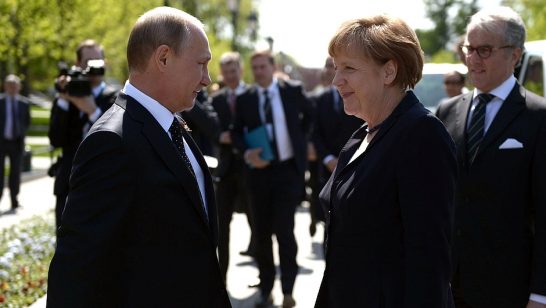
The rise of modern deterrence
Emerging conventional deterrence in the Euro-Atlantic is markedly different from the Cold War period not only in terms of scale, but also in quality. It reflects the growing reliance of Russian and Western militaries on high-readiness agile force rather than on larger, but less versatile mobilisational armies of the 20th century. While this evolution leads to postures which are presented as measured and unprovocative, in reality these pose real risks for stability between Russian and NATO militaries.
Since 2014, both Russia and NATO have increasingly settled in mutual balancing. The limited nature of conventional deployments on their border remains comforting news for those anxious about potential risks of a devastating clash between major powers in Europe. To some extent, this contrasts with heightened political rhetoric and concerns about non-traditional forms of coercion.
Instead of concentrating massive armies, modern deterrence presumes light forward presence with enhanced capacity for rapid reinforcement. In this regard, Russia increases the number of permanent-ready battalion task groups and conducts large-scale snap redeployments across long distances. On its part, the West invests in joint response forces, develops staff structures for logistics and interoperability, prepositions hardware for future deployments and combats bureaucratic and infrastructural barriers for troop movement.
The roots of agility
Both sides view limitations on forward presence as proof of their self-restraint. However, these limitations are driven more by overall force transformation and less by a de-escalation strategy. After the Cold War, both Russia and the West to a large extent stopped relying on large armies of conscripts, which required mobilization of reserves to achieve actual combat-readiness. They were replaced by smaller, yet nimbler professionalised force. Most of the NATO member-states abandoned the draft altogether, while Moscow continuously increased the share and emphasised the role of volunteers in its military ranks. Such development reflected not only new technological opportunities, but also increasing economic and demographic limitations.
In the last three decades, militaries across the Euro-Atlantic witnessed drastic reductions in budget and personnel. Meanwhile, chronic instability in the Middle East, accelerating arms races in the Asia-Pacific region and greater availability of Arctic for power projection, increased the geographical scope of their potential deployments. Under such circumstances, they can ill-afford replication of static layered defense from the Cold War era. They require to trade reduced size for greater speed and flexibility in force employment.
While Western pundits often accuse Russia of generating uncertainty regarding its military doctrine and activities, it was NATO that started transition to agile and, therefore, less transparent posture already since the 1990s (primarily due to the needs of out-of-area operations). Moreover, it was the US that officially proclaimed tactical unpredictability as its operational objective in 2018 National Defense Strategy. Nevertheless, Moscow emerged as a quick-learner and managed to adopt lessons of American expeditionary warfare in its challenge of compensating for numerical conventional superiority of the West.
The path to instability
Newly acquired agility contributes to the deceitful impression of safety in deterrence. Its primary risks, however, lie not in the lack of credibility of coercion as some have asserted. Instead, what becomes increasingly problematic is its proneness to crisis instability. Momentary aggravation of tensions will require both Russia and NATO to rely on aggressive concentration of forces and denial through preemptive deployment, which could be interpreted by an adversary as attempts to upset rather than uphold the status quo.
Although such measures aim for further political bargaining from a position of strength, they leave a lot of room for miscalculation by the other side. Dynamic force employment creates greater challenges for distinguishing intentions of adversaries than static postures do. This goes in line with the long-held conviction in the deterrence literature that greater flexibility could actually undermine, rather than foster capacity for signaling. During the Cold War both sides shared more or less defined thresholds for escalation with mobilisation as the critical one. It is harder to establish similar benchmarks for high-readiness militaries designed with the aspiration to strike without preparation.
Moreover, sophisticated professional forces are also more valuable than conscript armies, as they require longer time for replacement. This creates an incentive to avoid their exposure. Yet, in a crisis environment it could also make preventive strike options more appealing. After all, militaries are often tempted to go on the offensive, not when they are confident in a bright path towards victory (such optimism is rarely feasible), but when they are frustrated by a lack of better alternatives.
This criticism should not be seen as a justification for expansion of forward presence along the Russia-NATO border. Apart from the detrimental provocative effect it will have for further spiraling of bilateral tensions, such hefty upgrade is simply unsustainable given diverse threat profiles in the current security environment. Instead, this analysis provides another – and it could be argued stronger – rationale for greater emphasis on better management of adversarial relations in the Euro-Atlantic region.
The price of neglect
Despite a few advocates calling for measures in this direction (with the European Leadership Network being a notable example), Russia and NATO increasingly embrace modern conventional deterrence built around dynamic postures without major second thoughts regarding potential tradeoffs. In this context, most limitations and transparency instruments in the security field are increasingly perceived as barriers to the freedom to pursue velocity required by agile forces.
Previously developed regional arms control and confidence building measures could, indeed, be inadequate for the new security environment. However, this is mostly due to the low relevance of quantitative reductions and territorial restrictions for the currently predominant model of agile force rather than their ability to diminish its deterrent potential. Degradation of previously established norms regulating arms competition is unfortunate as they are not replaced by new mechanisms for controlling undesirable escalation.
So far, we have neither a good theory nor established practices for managing adversarial relations with relatively small, but agile postures. It is therefore important to align a search for creative and workable solutions for escalation control to the risks produced by doctrinal and organisational transformations, which often remain in the shadow of technological innovations. It is also imperative to encourage national militaries to challenge sometimes uncritical enthusiasm with dynamic postures, as well as fascination about lightness of modern deterrence.
The opinions articulated above represent the views of the author, and do not necessarily reflect the position of the European Leadership Network (ELN) or any of the ELN’s members. The ELN’s aim is to encourage debates that will help develop Europe’s capacity to address pressing foreign, defence, and security challenges.


